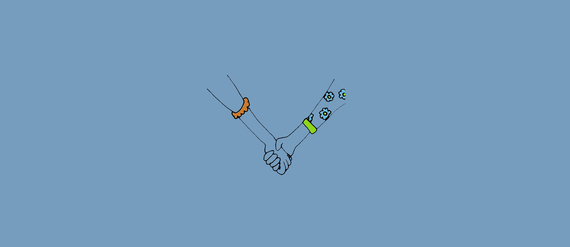As we take turns pushing her one-year-old brother in his stroller, my daughter asks me why people don’t just stay away from bad people, then they won’t be trafficked. I tell her that usually the story starts out with hope. In fact, sometimes it starts off like a fairy tale and the person can’t believe his luck. The trafficker may tell the person that she knows of a job where the person can make lots of money and help his family. Many times the person’s family is having a hard time. Maybe the person’s mom died or is sick and the person wants to help, needs …
As we take turns pushing her one-year-old brother in his stroller, my daughter asks me why people don’t just stay away from bad people, then they won’t be trafficked. I tell her that usually the story starts out with hope.
In fact, sometimes it starts off like a fairy tale and the person can’t believe his luck. The trafficker may tell the person that she knows of a job where the person can make lots of money and help his family. Many times the person’s family is having a hard time. Maybe the person’s mom died or is sick and the person wants to help, needs to help, somehow. This job solves the problem and finally, the person thinks, it will all be okay. Sometimes, the person gets to go on a plane to a brand new city or country. This seems exciting — but once he gets there, what seems like a dream quickly turns into a nightmare.
My daughter asks me why the person couldn’t tell that the trafficker was mean. I tell her that while traffickers are bad people that control, lie to, hurt and scare other people and force them to work without getting paid, they don’t usually look like bad people. A lot of the time they look kind and act really nice, at first.
This is hard for her to understand because in her mind if a person is mean on the inside they should look mean too, but that just isn’t the case. My daughter says, “Oh, so they can look nice and be mean just like the lady in Annie (she means Miss Hannigan in the remake of Annie, played by Cameron Diaz).”
I tell her, yes, they don’t have to look mean to be mean. My daughter responds by saying, “And just because a person acts nice, that doesn’t mean that they aren’t tricking you to do something bad to you.” “Exactly,” I say.
She asks me what traffickers do, exactly. When she thinks of traffic she thinks of cars, bikes and traffic signs, not people hurting people. I tell her that traffickers are people that make men, women and children work day and night, without pay. This makes them tired and sick.
They are forced to do all kinds of work, like make the clothing that we wear everyday, pick fruit, make bricks and ask for money. The traffickers make people live in places that aren’t clean or safe, and they don’t give them much food, sometimes just mashed vegetables or moldy bread, so they are often hungry. They also don’t take them to the doctor if they get sick.
My daughter responds by asking why the people who have been trafficked don’t leave. “If they can find a window and open it, can’t they run away?” she asks. I tell her the traffickers threaten to hurt the people if they try, and often the traffickers do hurt them — not just for trying to escape but just because the traffickers want to and can. This makes the people scared — they are scared the traffickers will hurt them again and scared they will hurt them, or worse, if they try to run away.
My daughter asks where traffickers go to find people to traffic. It seems unreal to her and must be happening far away, she can’t imagine it happening anywhere near where we live. I tell her the way trafficking happens is really similar no matter where it takes place, regardless if that is where we live or across the world.
We want to believe that trafficking can’t happen where we live, but it can and it does because it happens everywhere. Traffickers go to the same places we do, I tell her. They go where there are a lot of people like malls, schools, buses and train stations, and they use Facebook and other Internet sites to try to meet the people they will hurt. They can use classmates at school to recruit and find people to traffic. My daughter is little and this seems unreal, but it happens and we need to talk about it.
She asks me what to look out for and what to tell her friends. I tell her to beware of strangers. Stranger danger isn’t new to her, but it’s a new way to look at it. I tell her to know the clues and to tell an adult she trusts, a teacher or me, if she notices them. “What are the clues?” she asks.
Kids who are trafficked may miss a lot of school days and they may have bruises or be scared. They may be hungry, tired, have tantrums or outbursts, or their clothes may not make sense. Meaning, they may wear summer clothes when it’s cold. There may be an older person that hangs around the child but isn’t a family member and seems to tell her/him what to do. Sometimes, one clue alone doesn’t tell us much. I tell her that she doesn’t have to know for sure. “If you thinks something is wrong, even if it isn’t trafficking, it’s good to tell your teacher,” I say.
My daughter asks, but what if she is wrong? What if nothing is going on? “I don’t want to be a tattletale,” she says. I tell her that telling her teacher that she is worried about a friend or classmate is kind, it isn’t tattling. It gets confusing, I know, but I tell her to veer on the safe side and tell the teacher she is worried. She can always tell me too. Parents and teachers are busy and sometimes we don’t see what you see, I tell her.
Trust your instincts and share. It could save someone’s life.
If you suspect human trafficking, call the National Human Trafficking Resource Center toll-free at 1-888-373-7888.
The other day my daughter asked me some questions about human trafficking, which has been the focal point of my career over the past decade. I want to share her questions, thoughts and my replies because they quickly get at the root of people’s common misunderstandings about human trafficking. I hope our conversation helps you to talk to your little or big ones about this important topic.
You call see the full ebook version here (including fantastic illustrations by graphic artist James Guthman). This post originally appeared on The Good Blog.
— This feed and its contents are the property of The Huffington Post, and use is subject to our terms. It may be used for personal consumption, but may not be distributed on a website.
Link –























